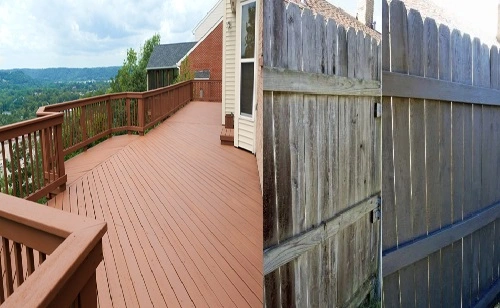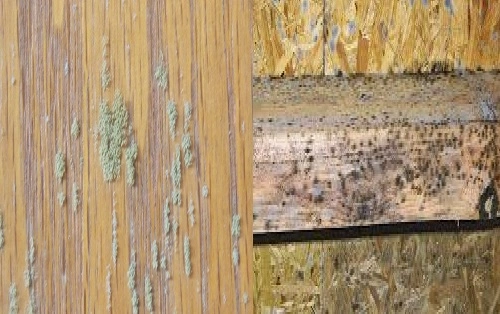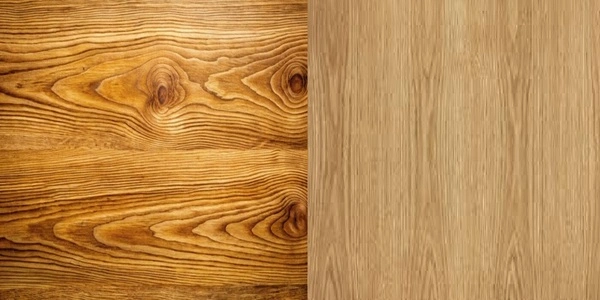If you have an older wood fence, keeping it protected and looking great is essential to prolong its lifespan and maintain curb appeal. Over time, exposure to sunlight, rain, and temperature changes can leave wood fences weathered, cracked, or faded. To restore and protect your fence, homeowners are often faced with two main options: solid stain or paint. While both serve the purpose of refreshing the look of the wood, they have significant differences in appearance, durability, and maintenance.
In this article, we’ll compare solid stain vs. paint for older wood fences and help you determine which is the best option for your next outdoor project.
Understanding Solid Stain and Paint
Solid Stain: Solid stain is a heavily pigmented product that provides an opaque finish, much like paint, but still allows the natural texture and grain of the wood to show through. It penetrates the wood’s surface while forming a protective layer on top. Solid stains are specifically designed for outdoor wood surfaces like fences, decks, and siding.
Paint: Paint is a surface coating that creates a thick, opaque layer that completely covers the wood grain. It is highly pigmented and provides a smooth, uniform finish. Exterior-grade paints are designed to protect wood from moisture, UV rays, and other environmental factors.
Key Differences Between Solid Stain and Paint
| Feature | Solid Stain | Paint |
|---|---|---|
| Appearance | Opaque but shows wood texture and grain | Opaque; completely covers wood grain |
| Penetration | Penetrates into the wood | Sits on top of the wood surface |
| Durability | Resistant to peeling; fades over time | Prone to peeling and chipping |
| Maintenance | Easier to touch up and reapply | Requires scraping and priming for touch-ups |
| Lifespan | 3–5 years depending on conditions | 5–7 years but prone to peeling issues |
| Water Resistance | Good water resistance | Excellent water resistance if intact |
| Application | Usually requires 2 coats; no primer | Requires primer and 2 coats of paint |
| Ideal Use | Older, weathered wood with texture | Smooth or less textured surfaces |
Benefits of Using Solid Stain on an Older Wood Fence
1. Penetrates the Wood: Solid stain penetrates into the wood fibers, creating a bond that enhances durability and resists peeling. This is especially beneficial for older wood, which may have cracks or imperfections that paint might not adhere to properly.
2. Preserves the Natural Texture: While solid stain is opaque and hides the color of the wood, it still allows the wood’s natural texture and grain to remain visible. This gives your older fence a rustic and natural look.
3. Easier Maintenance: Solid stain wears down gradually over time, meaning it won’t peel or crack like paint. When it’s time to reapply, you don’t need to scrape off the old coating—simply clean the surface and apply a new coat of stain.
4. Good Water Resistance: Solid stains are formulated to repel moisture and protect the wood from rot and mildew. For older wood that may already show signs of aging, this extra protection helps prolong the fence’s life.
5. No Primer Required: Solid stain typically does not require a primer, which makes the application process faster and more cost-effective.
Benefits of Using Paint on an Older Wood Fence
1. Uniform Coverage: Paint provides a thick, opaque coating that completely covers the wood grain and any imperfections. For older wood fences that are heavily weathered, paint can hide blemishes, cracks, or discoloration effectively.
2. Superior Color Options: Paint offers an extensive range of colors, finishes, and sheens, allowing you to customize your fence to match your home’s style or landscaping.
3. Excellent Protection Against Moisture: A well-applied coat of high-quality exterior paint acts as a barrier against moisture, preventing water from penetrating the wood. This is particularly useful for older wood fences that may already have weakened areas.
4. Longer Lifespan (If Maintained): When properly applied with a primer and multiple coats, paint can last 5–7 years on a wood fence before needing a fresh coat.
5. Ideal for Smooth Surfaces: If your fence has been sanded or repaired and the wood surface is relatively smooth, paint can provide a polished, finished look that transforms the fence completely.
Drawbacks of Solid Stain and Paint
Solid Stain:
- While it’s easier to maintain, solid stain does not last as long as paint and typically needs reapplication every 3–5 years.
- Stain provides limited color options compared to paint.
Paint:
- Paint tends to peel, crack, and chip over time, particularly on older wood that expands and contracts with weather changes.
- Maintenance is more labor-intensive, requiring scraping, priming, and repainting every 5–7 years.
- The thickness of paint may not adhere well to older, textured wood, leading to premature failure.
Which Should You Choose?
- Choose Solid Stain If:
- Your fence is old, weathered, and textured.
- You want a low-maintenance solution that won’t peel or crack.
- You prefer a natural look that preserves the wood texture.
- You want a faster application process without primer.
- Choose Paint If:
- Your fence has been sanded or repaired, and you prefer a smooth, uniform finish.
- You want a broader range of color options.
- You are prepared for more intensive maintenance and preparation.
- Your fence is in relatively good condition and free of major cracks or imperfections.
Steps to Apply Solid Stain or Paint on an Older Fence
- Clean the Fence: Use a power washer or a wood cleaner to remove dirt, mildew, and old coatings. Allow the wood to dry completely.
- Make Repairs: Replace or repair damaged boards, and sand down any rough spots.
- Choose the Right Product:
- For stain, use a high-quality solid stain formulated for exterior wood.
- For paint, apply an oil-based primer before using exterior-grade paint.
- Application:
- For solid stain: Use a brush, roller, or sprayer to apply 2 coats.
- For paint: Apply 1 coat of primer and 2 coats of paint. Allow each coat to dry fully.
Conclusion
Both solid stain and paint are excellent options for refreshing and protecting an older wood fence, but the right choice depends on your goals. Solid stain excels in ease of maintenance, moisture resistance, and preserving wood texture, making it ideal for older, weathered fences. Paint, on the other hand, offers better coverage and a polished appearance but requires more intensive maintenance over time.
By understanding the strengths and limitations of each option, you can choose the best solution to give your fence new life while protecting it for years to come. Whether you prefer the rustic appeal of solid stain or the bold finish of paint, your fence will look great and stand strong with the right care.


